
Here’s a truth few fitness folk realize: women’s training should be almost identical to men’s.
The reason?
The principles that drive muscle growth are the same for both men and women.
(There are a few minor exceptions, which you’ll learn about in this article).
Why, then, are women’s workout splits often quite different from male workout splits?
Mainly because of preferences—most women want a bigger butt and more defined legs, whereas most men want a more muscular upper body.
Thus, the best workout split for women boils down to training the same way guys do while focusing on a different set of muscles.
In this article, you’ll learn how to choose the best workout split for your goals, the three best workout splits women can do, and more.
Key Takeaways
- A well-designed workout split helps you train with purpose, stay consistent, and make steady progress.
- Women’s workout splits should follow the same principles as men’s but emphasize different muscle groups based on preference.
- The best workout split for you depends on how many days per week you can train, your experience level, and which muscles you want to prioritize.
- Full-body, upper lower, and push pull legs splits are all effective—pick the one that suits your goals and schedule.
- To get the most out of any women’s workout split, consider using a high-quality protein powder to help you reach your daily protein target, creatine to support recovery and muscle growth, and a pre-workout to enhance energy, focus, and performance.
Table of Contents
+
What Is a Workout Split for Women?
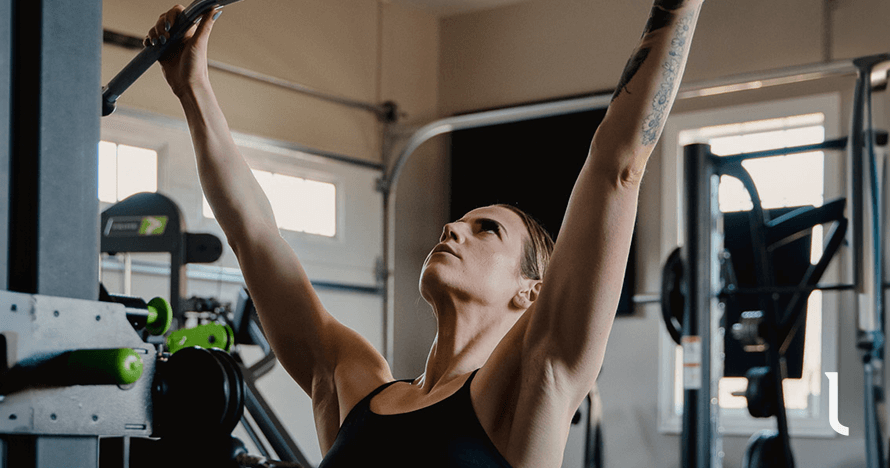
A workout split is a way of dividing (or “splitting”) your training plan across different days to focus on specific muscle groups or types of exercise on each day.
For example, you might train your legs one day, your shoulders another day, and so forth, allowing each muscle group adequate recovery time while you train the others.
A workout split for women is simply a workout split tailored to most women’s goals, preferences, and, to a lesser extent, physiology. The basic structure is the same as men’s, but women’s splits usually emphasize the areas most women want to develop—especially the legs and glutes.
Common workout splits for women include full-body, upper lower, and push pull legs routines.
Benefits of Following a Workout Split for Women
Following a workout split for women has several advantages over just winging it in the gym:
- It keeps your workouts focused and purposeful because you’re following a plan, not guessing.
- It makes tracking progress easier since you repeat the same key exercises each week.
- It guarantees you train all your major muscle groups so you don’t develop muscle imbalances.
- It builds rest and recovery into your week instead of leaving them to chance.
- It increases your odds of losing fat, building muscle, and getting stronger, which makes it easier to stay motivated.
How to Choose the Best Women’s Workout Split for Your Goals & Schedule
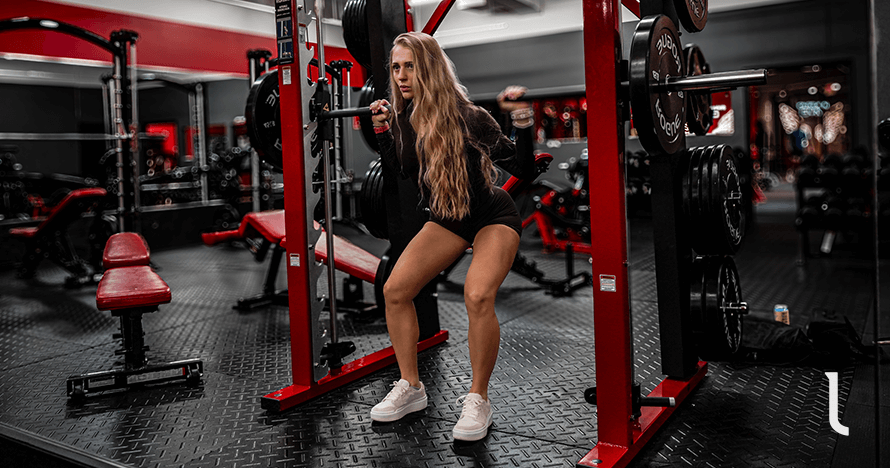
While there are many workout splits for women, only a handful are worth doing. To choose the right one for you, ask yourself three questions:
- What can I consistently do every week?: It’s better to follow a simple workout split consistently than a “perfect” one sporadically. Be honest about how many days you can realistically lift.
- What suits my experience level?: Beginners can make excellent progress doing just 3 or 4 workouts per week. More experienced weightlifters will progress faster with 4 or 5.
- What muscle groups do you most want to develop?: Different workout splits prioritize different muscle groups. Choose one that lines up with your goals—whether that’s building a firmer butt, getting rid of your “pear shape,” or creating more of an hourglass figure.
Best 3-Day Workout Split for Women: Full-Body
Full-body workout splits have been around forever, but they’ve made a comeback in recent years, especially among women.
Part of the reason is that research suggests women recover faster from their workouts than men, so they can benefit from training each body part more frequently than once or twice per week. And full-body workout splits are as “high frequency” as strength training plans come.
The idea behind full-body 3-day workout splits is simple: you train every major muscle group in each of your three weekly workouts.
Here’s how this might look:

The main benefits of a 3-day workout split for women are:
- You don’t get brutally sore because you never hammer any single muscle group with lots of sets in a single workout.
- It’s flexible—if you miss a day, it doesn’t derail your whole week.
- It may help you build muscle by keeping muscle protein synthesis rates elevated more than other splits.
The only significant drawbacks are that full-body workouts tend to be slightly longer than other workouts, and because you train each major muscle group several times weekly on a full-body split, you can run yourself into the ground if you don’t manage your volume and exercise selection.
Example Full-Body 3-Day Workout Split for Women
Here’s an example full-body 3-day workout split you can follow (or use as a template to build your own program):
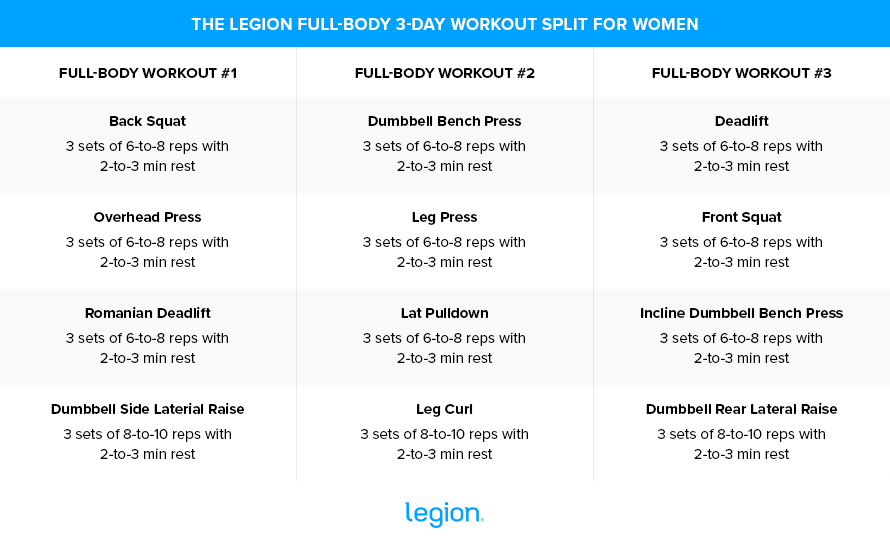
Best 4-Day Workout Split for Women: Upper Lower
The 4-day upper lower workout split divides your weekly workouts into two upper-body workouts and two lower-body workouts for a total of four training days a week.
On your upper days, you train the muscles of your upper body—your chest, back, shoulders, and arms. On lower days, you train the muscles in your lower body—your quads, hamstrings, glutes, and calves.
Here’s how you might schedule your workouts on an upper lower 4-day workout split:

This 4-day workout split for women is popular because it’s simple, time-efficient, and gives you a good mix of volume, frequency, and recovery. It also devotes more time to lower-body training than most other workout splits.
While there aren’t any inherent problems with the upper lower split, workouts can drag if you organize it poorly. For instance, trying to train your chest, back, shoulders, biceps, triceps, and core in the same session can take a long time.
A better approach is to split your upper body across the week—for instance, train your chest and back on one upper day and your shoulders, arms, and most of your core work on the other.
You also don’t need to spend the same time training your upper body as your lower body. If you care more about getting shapely legs and a rounder butt than building your upper body, you can simply make your lower-body workouts a bit longer and your upper-body workouts a bit shorter.
Example Upper Lower 4-Day Workout Split for Women
Here’s an example upper lower 4-day workout split that’s ideal if you want to build your whole body while putting extra emphasis on your legs and glutes:
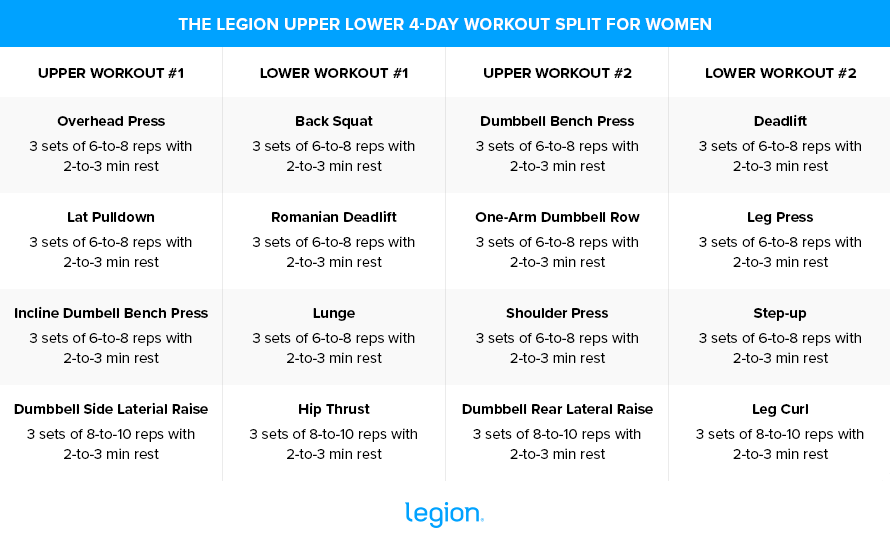
Best 5-Day Workout Split for Women: Push Pull Legs (PPL)
The idea of the push pull legs (PPL) split is simple:
- Push days train the muscles that push things away from your torso, like your chest, shoulders, and triceps.
- Pull days train the muscles involved in pulling things off the floor or toward your torso, like your back and biceps.
- Leg days train your quads, hamstrings, glutes, and calves.
PPL workout routines work well because the muscles involved in pushing and pulling movements don’t overlap much.
For instance, your chest, shoulders, and triceps work during a pushing exercise like the bench press, while your back and biceps take a back seat. Conversely, your back and biceps do most of the work in a barbell row, allowing your pushing muscles to rest.
By rotating between push, pull, and leg workouts, you can train different body parts while others recover, so you start each workout feeling fresh.
There are many ways to organize a push pull legs routine, but for women who want to emphasize their lower body, a 5-day schedule like this works best:

A major benefit of a push pull legs 5-day split workout is it allows you to train your lower body with plenty of volume, which is generally beneficial for growth. It also gives you enough time to work on your upper body, helping to prevent imbalances between your upper and lower halves.
That said, a 5-day PPL split isn’t for everyone. It demands a lot of time in the gym and careful attention to sleep, diet, and recovery. For most women, especially beginners and early intermediates, five lifting days per week is more than you need.
Unless you’re an experienced weightlifter (more than three years of consistent training experience) who has plateaued on an easier routine, a less demanding workout plan might be a better fit.
Example Push Pull Legs 5-Day Workout Split for Women
Here’s an example push pull legs 5-day workout split for women that’s ideal for experienced weightlifters looking to maximize muscle and strength gain:
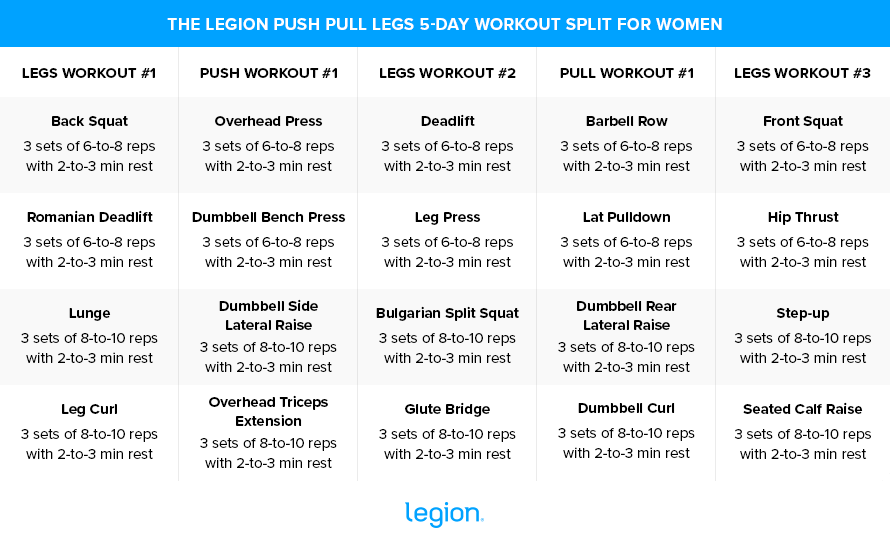
The Best Supplements for Women Following a Workout Split
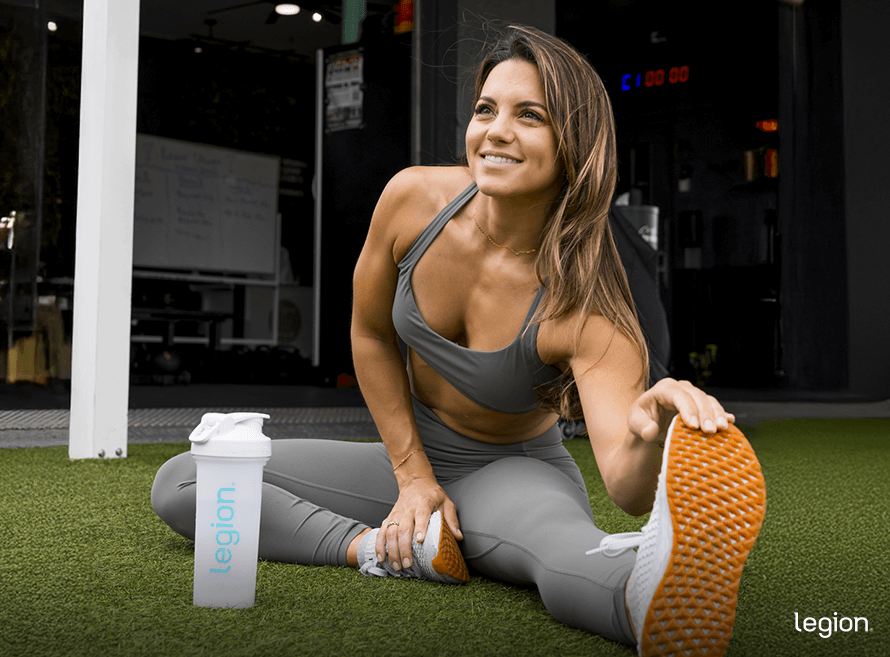
No matter what workout split you follow, supporting your training with the right supplements can help you build muscle, recover faster, and get better results.
Here are three worth considering:
- Protein powder: Protein powder, such as whey or casein, provides your body with the nutrients needed to build muscle tissue and recover from workouts. For a clean and delicious protein powder, try Whey+ or Casein+.
- Creatine: Creatine boosts muscle and strength gain, improves anaerobic endurance, and reduces muscle damage and soreness from your workouts. For a natural source of creatine, try our creatine monohydrate, creatine gummies, or Recharge.
- Pre-workout: A high-quality pre-workout enhances energy, mood, and focus, increases strength and endurance, and reduces fatigue. For a top-tier pre-workout containing clinically effective doses of 6 science-backed ingredients, try Pulse with caffeine or without.
(If you’d like even more specific advice about which supplements you should take to reach your health and fitness goals, take the Legion Supplement Finder Quiz, and in less than a minute, you’ll know exactly what supplements are right for you.)
The Bottom Line on Workout Splits for Women
There’s no single “best” workout split for every woman. The best workout split for you is the one you can stick to, that fits your schedule, and that lets you train the muscles you care about most with enough recovery to keep making progress.
For most women, that means starting with one of three options:
- A 3-day full-body split if you’re a beginner or busy and can realistically lift three days per week.
- A 4-day upper lower split if you want a balanced plan that lets you train your whole body while putting extra time into your legs and glutes.
- A 5-day push pull legs split if you’re an experienced lifter who enjoys being in the gym often and is willing to prioritize recovery.
Pick the split that matches your current lifestyle and experience, run it consistently for at least 3–6 months, and focus on getting a little stronger over time.
If you do that—and eat and recover well—you’ll build muscle, get stronger, and move closer to the body you want, no matter which workout split for women you choose.
FAQ #1: What is the best workout split for female beginners?
For most women new to weightlifting, a 3- or 4-day workout split works best. It gives you enough training to build muscle and strength while still leaving plenty of time to recover.
This goes against what many online fitness “gurus” claim—you’ll often hear that you have to train 5–6 days per week to see results.
But having worked with thousands of women through Thinner Leaner Stronger and Legion’s body transformation coaching, I’ve consistently found that 3–4 workouts per week is plenty.
And if you’d like proof, here are a few coaching clients who got amazing results in just a few months using this exact approach:

FAQ #2: What is the best workout split for women?
The best workout split for a woman depends on your fitness goals, experience level, and schedule. In most cases, the best split is the one you can follow consistently, that gives you enough recovery, and that prioritizes the muscle groups you most want to develop.
FAQ #3: What’s a good gym schedule for women?
A good gym schedule for women balances workout frequency with recovery time. Beginners can make excellent progress with 3 or 4 weekly workouts, while more experienced lifters may benefit from 4–5.
Ignore anyone who says you need to train more than this. While 6- and 7-day workout splits for women exist, they’re almost always too demanding. For most women, taking at least two rest days per week—often the weekend—works best.
FAQ #4: What is the best 5-day workout split for women?
The push pull legs 5-day workout split is highly effective for women looking to emphasize lower body growth while maintaining upper body strength and balance. However, it requires you to prioritize recovery and spend a lot of time in the gym, making it less suitable for beginners or those with limited time.
FAQ #5: What’s the best workout split for fat loss?
While strength training can help boost fat loss, it doesn’t drive it as well as a calorie-controlled diet.
For specific advice about how many calories, how much of each macronutrient, and which foods you should eat to reach your health and fitness goals, take the Legion Diet Quiz, and in less than a minute, you’ll know exactly what diet is right for you. Click here to check it out.)
Want More Content Like This?
Check out these articles:
- The Ultimate 3-Month Female Body Recomposition Workout Plan
- How to Get Rid of Armpit Fat: Workouts, Exercises & Diet
- The Best Postpartum Workout Plan for Full-Body Strength
Scientific References +
- Hagstrom, Amanda D, et al. “The Effect of Resistance Training in Women on Dynamic Strength and Muscular Hypertrophy: A Systematic Review with Meta-Analysis.” Sports Medicine (Auckland, N.Z.), 2019, pp. 10.1007/s40279-01901247-x, www.ncbi.nlm.nih.gov/pubmed/31820374, https://doi.org/10.1007/s40279-019-01247-x. Accessed 12 Dec. 2019.
- Judge, Lawrence W., and Jeanmarie R. Burke. “The Effect of Recovery Time on Strength Performance Following a High-Intensity Bench Press Workout in Males and Females.” International Journal of Sports Physiology and Performance, vol. 5, no. 2, June 2010, pp. 184–196, https://doi.org/10.1123/ijspp.5.2.184.
- Stokes, Tanner, et al. “Recent Perspectives Regarding the Role of Dietary Protein for the Promotion of Muscle Hypertrophy with Resistance Exercise Training.” Nutrients, vol. 10, no. 2, 7 Feb. 2018, p. 180, www.mdpi.com/2072-6643/10/2/180/pdf.
- Eckerson, Joan M., et al. “Effect of Creatine Phosphate Supplementation on Anaerobic Working Capacity and Body Weight after Two and Six Days of Loading in Men and Women.” The Journal of Strength and Conditioning Research, vol. 19, no. 4, 2005, p. 756, https://doi.org/10.1519/r-16924.1.
- Bassit, Reinaldo Abunasser, et al. “Effect of Short-Term Creatine Supplementation on Markers of Skeletal Muscle Damage after Strenuous Contractile Activity.” European Journal of Applied Physiology, vol. 108, no. 5, 3 Dec. 2009, pp. 945–955, https://doi.org/10.1007/s00421-009-1305-1.













